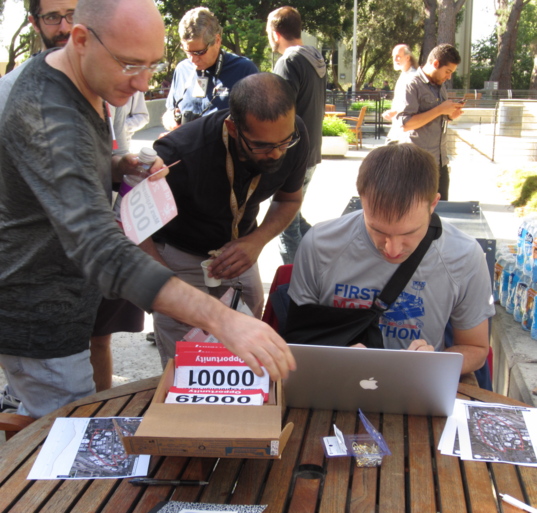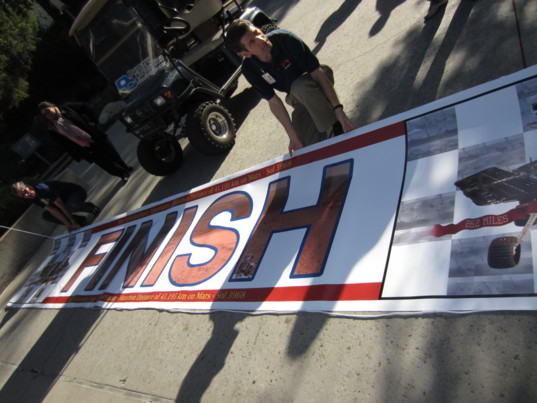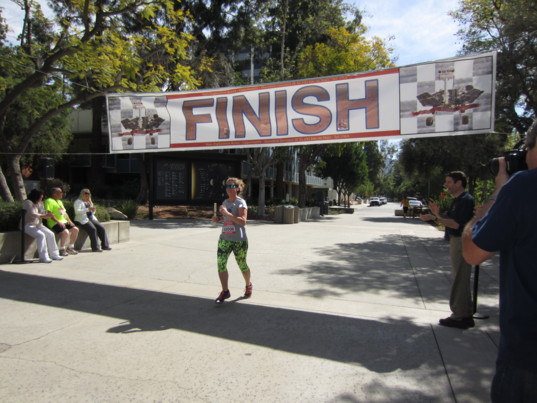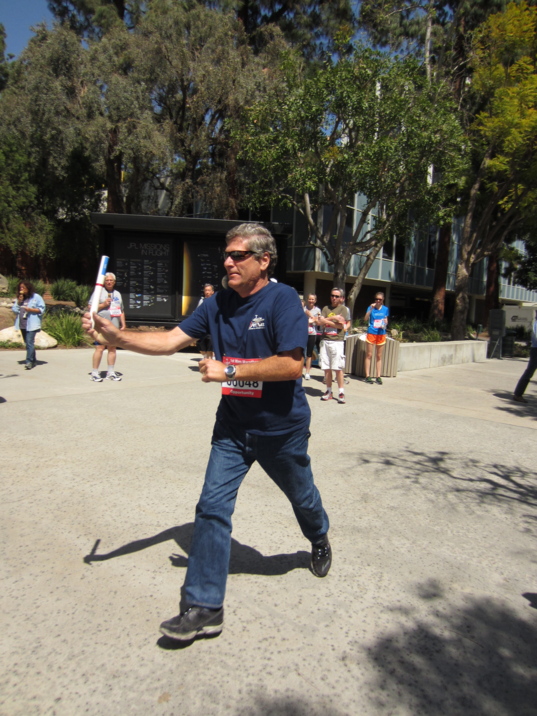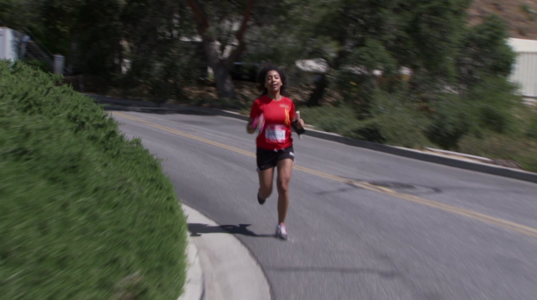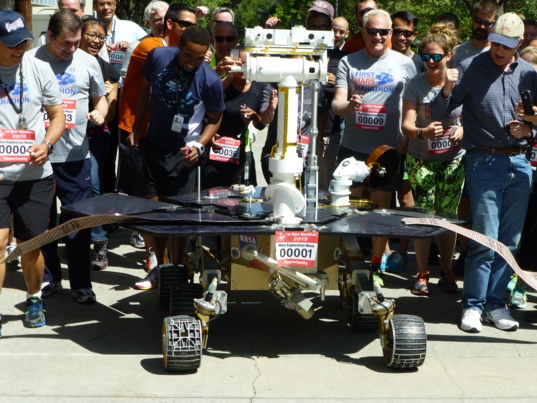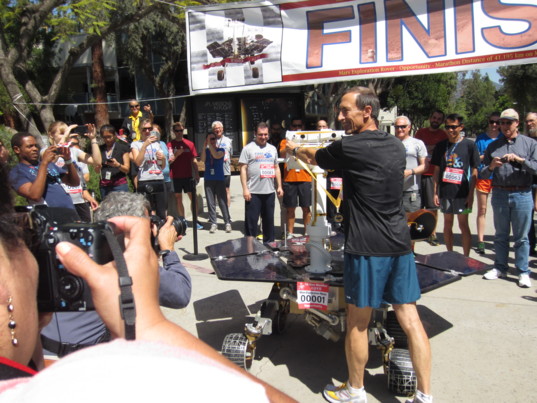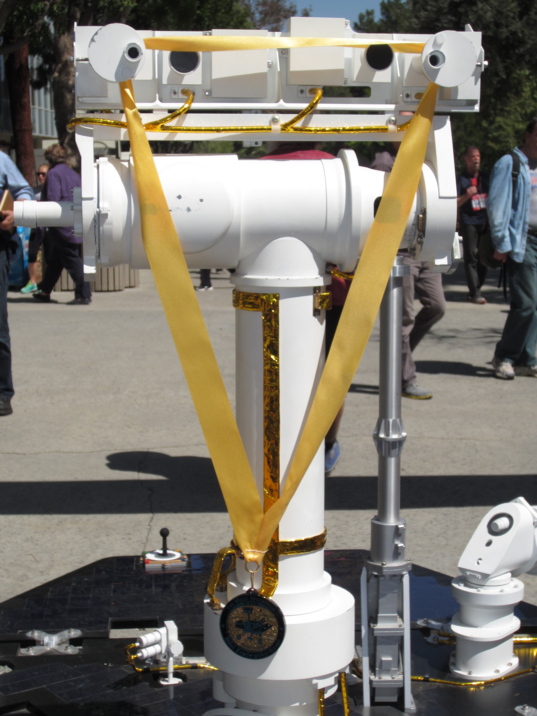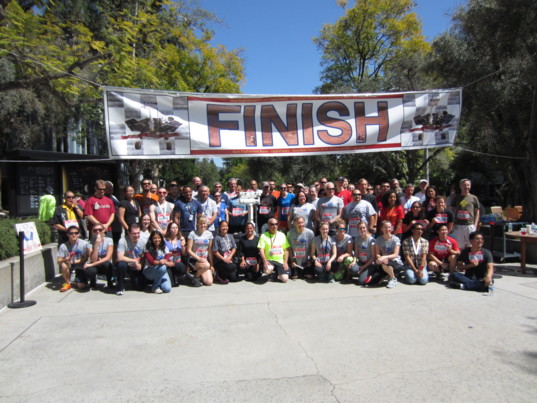A.J.S. Rayl • May 01, 2015
Mars Exploration Rovers Special Update: MERathon Celebrates Opportunity's Marathon
It was – April 9, 2015 – a pleasantly sunny, southern California day at the Jet Propulsion Laboratory (JPL). The temperature was a brisk 52-Fahrenheit in the morning, but would rise to the high-70s by afternoon, about average for this time of year. The sky overhead was almost a robin's egg blue with a scattering of clouds, a picture perfect day for something out of the ordinary.
At JPL, of course, out of the ordinary things happen all the time. It is home to all of NASA's Mars rovers and so many other robotic planetary missions, including veterans like Voyager, now in interstellar space, and Cassini at Saturn, Juno, en route to Jupiter, and InSight, a lander to blast-off for Mars next March, among others. Even so, today would be memorable. An out of the ordinary celebration of an extraordinary achievement some 50 million miles away was about to begin...
"Here we are – the first Mars Marathon at the Jet Propulsion Laboratory celebrating Opportunity completing a marathon on Mars," said John Callas, MER project manager during an interview shortly before the humans got rolling.
It had been a long time coming...11 years and two months, actually...but on March 24, 2015 Mars Exploration Rover (MER) Opportunity roved past 42.195 kilometers (26.2 miles) and finished the first marathon on another planet.
Now, on this particular day, MER mission ops team members would be joined by other engineers and scientists, some who previously worked on the MER mission, to take on the challenge of a relay marathon to celebrate Opportunity's milestone achievement. Before the day was through, more than 90 JPLers would take part, each running a 1.2-mile lap or more, up the hills and along the roads that wind through the Lab's grounds. Together, they would complete a marathon.
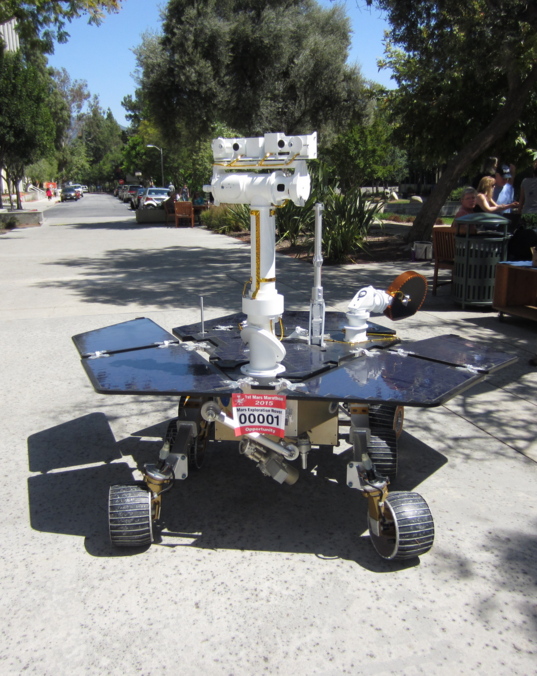
A.J.S. Rayl
Mars Exploration Rover "Run-In"
Opportunity's "run-in," aka Bubba, arrived early for the celebration of the Mars Exploration Rover's marathon achievement held at the Jet Propulsion Laboratory on April 9, 2015. Opportunity roved past 42.195 kilometers / 26.2 miles on March 24, 2015 during her exploration along the western rim of Endeavour Crater.Opportunity seemed to promise from the beginning that her expedition of Meridiani Planum would be a thrilling adventure. For the world, it began with the robot's bounce-down to landing. When she rolled to a stop inside Eagle Crater, scoring Earth's first interplanetary hole-in-one, everyone, everywhere cheered. But no one back then even dreamed that this rover would drive long and far enough to log a marathon.
Although Opportunity's prime directive has always been about science and discovery, not setting long distance records, as the years went by, kilometers and miles kept accumulating, and the rover set distance record after distance record, surprising everybody.
Then, last year, the robot field geologist chalked up her 40th kilometer and 25th mile, exceeding the all-time rover distance record of 39 kilometers (about 24 miles) set by the Russian Moon rover Lunokhod 2 in 1974. In addition to being the longest-lived robot on another planet, Opportunity had claimed the distance record, the title of most-traveled robot on another world. A marathon seemed clearly within reach.
By all accounts, Opportunity roved beyond remarkable long, long ago. Still, when this little 'bot drove into the apron area surrounding Spirit of St. Louis Crater and crossed an imaginary finish line to complete the first marathon on Mars, the first marathon on another planet, even the most solemn and stoic of engineers and scientists had to pause. "The mission objective, remember, was 600 meters," chuckled Callas.
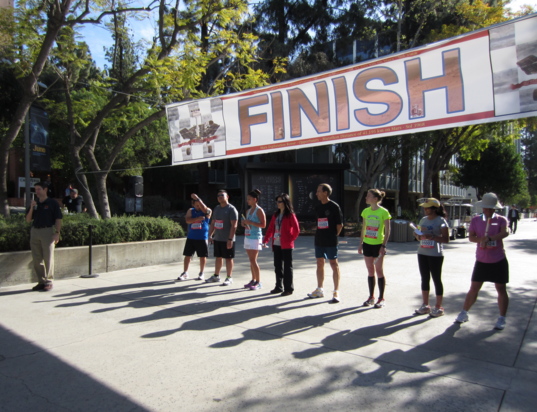
A.J.S. Rayl
Ready, set...
From right to left: Feiming Morgan, a member of the Spectrum Engineering Group; Nimisha Mittal, a spaceflight operations engineer for MER and other missions; Amanda Steffy, mission operations engineer for Curiosity; JPL Deputy Director Larry James; Amy Chen, who served as an image processing lead for MER; Lynne Lee, the manager for engineering and construction safety; and safety engineers T Nilawat and Anthony Lopez, take their positions at the starting line – and begin the first Mars Marathon on Earth.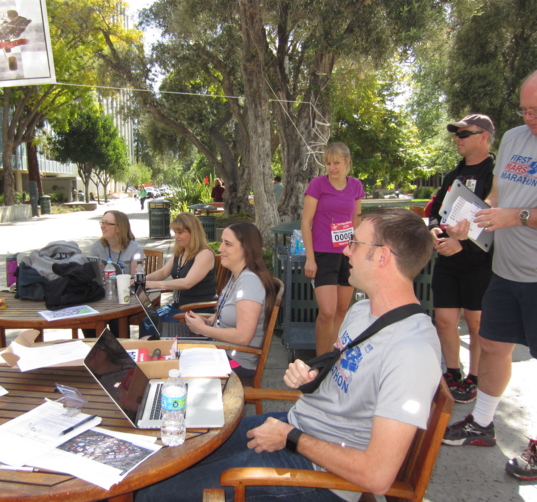
A.J.S. Rayl
Setting up shop
MER ops team members, Mike Seibert, Heather Justice, Ashley Stroupe, Vickie Scarffe- Barrett, and Kirsten Siebach (in the magenta tee-shirt) set up shop and tended to work between laps. While the MER team and dozens of others at JPL celebrated Opportunity's marathon achievement, the rover on Mars still needed her ops team.By 8:30 am, dozens of JPL-ers, many sporting grey Mars Marathon running shirts, were gathering in the main mall area of the NASA center to check in and get their bibs for the race. People from all across the Lab had signed on to participate. An injured Mike Seibert, Opportunity rover planner and lead flight director, had assumed bib-dispensing responsibility.
If it hadn't been for a ski accident that left him with a broken shoulder, Seibert, who is a marathoner, would have been running himself. In fact, this whole event evolved out of his plan to run a marathon when Opportunity had completed her "race" on the Red Planet.
The LA Marathon, held March 15, 2015, was "near perfect timing" and Seibert signed up. He talked with a few of the MER ops team members about joining him. "But no one really wanted to commit to it. A marathon is a big, long race, from three hours to five hours, and longer. You can see why a lot of people didn't go, 'Yeah, let's go run the LA Marathon,'" he said.
But the idea of a marathon celebration of Opportunity's achievement resonated. With a little help from the JPL Running Club, word of a possible celebratory marathon run spread. Enthusiasm made it a reality. This was "the first time a human enterprise has achieved a marathon's distance on another planet," as Callas put it. People from all over the Lab wanted to acknowledge Opportunity's achievement.
"When MER launched, something like one-third of the folks on lab had worked on the mission in some capacity," Seibert pointed out. "People often don't realize it, but there really are a lot of people who have put a lot of time and effort into designing, building, launching, landing, and operating these rovers. It's not just those of us on the project right now who wanted to celebrate, but a lot of folks here who were part of the MER team and others who are just interested in this mission."
Given that so many engineers and scientists were ready to run and that only a handful were experienced marathoners, the concept soon morphed into a marathon relay, where participants would run laps to achieve the marathon distance of 26.2 miles. It would be a "friendlier" run and allow for more participants.
The word 'relay' is an all too familiar term, and so the MER team marathon planners quickly dubbed it the UHF Relay, after the critical link between the rover and the orbiters, Mars Odyssey and sometimes Mars Reconnaissance Orbiter, which are the conduits to getting the rover's images and science and engineering data down to Earth.
While Callas, Seibert, and other team members considered routes that would take runners from the Lab to the Rose Bowl and back, they opted for a more contained lap within the perimeters of the laboratory grounds. "While JPL is a good sized center, wedging 26.2 miles into the perimeter, while taking into account heavily trafficked roads, limited our options," said Seibert.
Then again the MER team is legendary for its uncanny ability to work around problems and meet challenges. In short order, they devised a 1.2-mile loop that began in the mall area and took the runners up the steep hill along the center's western boundary and around the back of the Lab, and back around to finish at the start point in the mall. "It would require 22 laps to make a marathon," said Seibert.
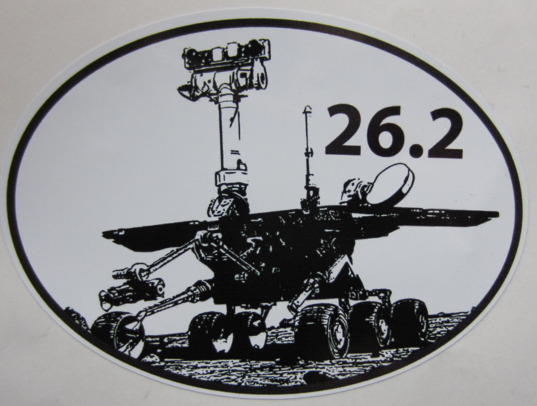
Sticking with history
The father of Rebekah Sosland, MER flight director, Steve Sosland, surprised his daughter with stickers honoring Opportunity's historic run. What prompted the gift? "I am a huge fan of the MER team's work. What they're doing on Mars and keeping this rover going, is phenomenal," said Sosland, Senior Vice President and People Officer at the University of North Texas Health Science Center in Ft. Worth. "Bekah constantly reminds me this is a team effort and I wanted to give something to her to help recognize the team." And, he added, "I love my daughter."As the runners began warming up, Kris Capraro, who prepares many of the big panorama scenes from Opportunity, arrived with the Finish line banner, and rolled it out. Just like all of the images and scenes that come from Capraro's office, it was impressive.
While Capraro and Callas waited for a ladder and the help of maintenance men to lift and hang the banner, a cyclist appeared seemingly out of nowhere. Oblivious or perhaps blinded by the morning Sun, he rode right onto the banner. Fortunately, the banner survived, suffering only a couple of wrinkles, and within minutes, it was safely up and marking the start and finish line. The stage for the first Mars Marathon was set.
Like most marathons, the skill level of runners varied. There were a few hard-core runners, marathoners like Amanda Steffy, a mission operations engineer on MSL/Curiosity. It would be her "last workout" and a "fun warm-up" before she went to the Boston Marathon 11 days later. And there were those, like Capraro, who wore their regular, day 'uniforms' of tee-shirt and jeans.
Other MER team members and JPLers, including Ashley Stroupe, an Opportunity rover planner and robotic engineer, couldn't run – "bad knee" – but opted to bring their work outside to be able to observe and cheer the runners on.
Only the rover was missing. Opportunity was of course still busy on Mars – in the midst of examining a light-toned outcrop near the Spirit of St. Louis actually. But Bubba, a ground-based test rover was brought in to be her "run-in."
The caveat was that Bubba would take the last "lap" and break through the finish-line tape at the end of the celebration, after the human runners completed the first ever UHF Relay Mars Marathon.
At 9 am, the first Mars Marathon on Earth began.
"Are you ready?" Callas asked.
Feiming Morgan, a member of the Spectrum Engineering Group, Nimisha Mittal, a spaceflight operations engineer for MER, Cassini, and other missions, Amanda Steffy, Curiosity mission operations engineer, JPL Deputy Director Larry James, Amy Chen, who served as an image processing lead for MER, Lynne Lee, the manager for engineering and construction safety, and safety engineers T Nilawat and Anthony Lopez, assumed their marks at the starting line.
"Get set. Go!"
The runners were off and running.
By the time all was said and run, a total of 93 JPL engineers and scientists representing eight relay teams, took part.
Named Spirit, Opportunity, MIPL [Multi-mission Instrument Processing Laboratory], Dust Cleaning Event, Eagle Crater, Endurance Crater, Victoria Crater, and Endeavour Crater, the running teams were comprised of anywhere from five runners to 16 runners, and each team successfully completed a marathon's distance.
The Opportunity team was the only team made up of all MER ops team members and featured (in alphabetical order): Kyle Cloutier, tactical uplink lead; Eric Ferguson, flight director; Olya Filimonova, tactical activity planner/sequence integration engineer; Danny Forgette, thermal engineer; Hallie Gengl, rover planner; Heather Justice, rover planner; Nimisha Mittal, tactical uplink lead; Tam Nguyen, data management engineer; Shane Pootrakul, lead thermal engineer; Nicholas Ruoff, image processing engineer; Kirsten Siebach, engineering camera payload uplink lead; Bekah Sosland, flight director; Richard Springer, mission manager; Paul Stella, power engineer; and Kiri Wagstaff, tactical uplink lead.
"If at launch, you would have tried to describe such an event to me, that eleven-and-a-half years in, we would have the MER team still going, running a marathon -- with participants who were 13-year-olds at the time that we launched the spacecraft – celebrating Opportunity's marathon on Mars – you know, incredulous doesn’t begin to capture how I would have felt," reflected Steve Squyres, MER principal investigator, of Cornell University, via telephone. "I wish I could have been there."
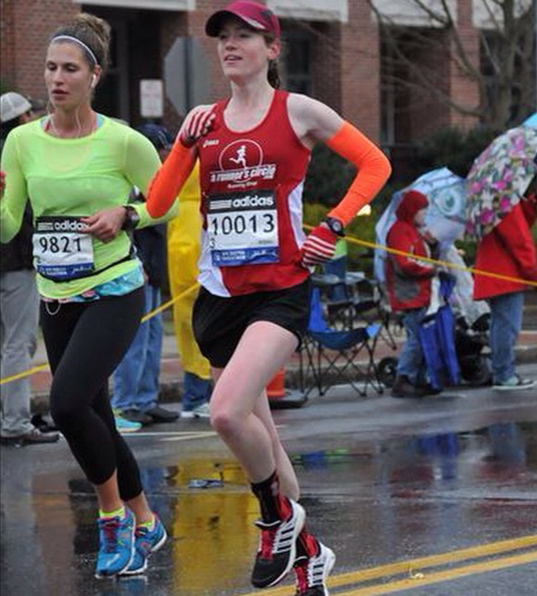
MarathonPhoto
From Mars to Boston
From the balmy climes of southern California and a "fun" celebratory Mars Marathon, Amanda Steffy, a mission operations engineer on Mars Science Laboratory/Curiosity, joined the ranks of the truly serious, braved the cold and rain, and ran the Boston Marathon on April 20, 2015. Although she suffered a bit of hyperthermia due to the weather, she finished with an impressive time of 3 hours and 27 minutes. "There's such tradition and history to the Boston Marathon," she said afterward. "Bostonians came out to cheer on the runners even though the wind chill was in the 30s and it was raining heavily. Even though I was really hurting at mile 25, it was amazing to be running through the city and have crowds of people cheering you on.""It went really well," said Seibert, after the event. "The morning was hectic, but every race day morning is hectic, because everybody shows up at once to get their bibs. Once we were off and running, we established a really good cadence to getting everybody through and handing off the batons," he said.
"We talk all the time about how many kilometers Opportunity's has gone, and we get to 42.195 kilometers (26.2 miles) – and for most people it's just another number and we can throw that around all day long," Seibert said. "But you say a 'marathon' and with most people that clicks. They know how far that is. It puts in perspective how far this rover has gone."
It's been fun," said Callas at day's end. "We had a lot of enthusiasm and a lot of excitement, and I'm pleased and excited by all the interest and the fact that people want to do this again."
It may well be that Opportunity, the long distance planetary exploration rover of record, wants to do it again too.
"When you're a distance runner, there's always something else out there that's farther and another test of your endurance, and if you want to go chase it, you can," said Seibert, who is "back to having more working shoulder joints" than the rover.
If ever there was – and is – a testament to American engineering and a rover so willing to chase another marathon on Mars, it's Opportunity.
Time, as always, will tell. In any case, the seemingly impossible notwithstanding, Opportunity's marathon on Mars was not the finish line for this rover. "It's merely another milepost," summed up Callas, "in this rover's tremendous accomplishments of exploration and discovery on Mars."
Click here for JPL's video recap of the race.
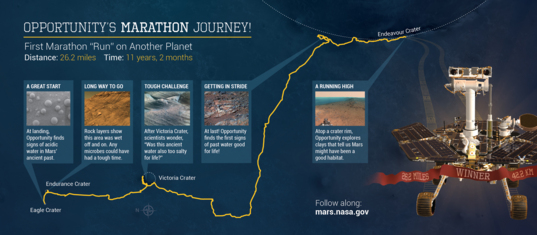
NASA / JPL-Caltech / Cornell / USGS / Arizona State University
Opportunity's epic run
This graphic depicts some of the highlights along the route Opportunity drove during the first 11 years and two months of her mission, from her January 2004 landing in Eagle Crater to the finish line of her marathon race. The rover surpassed a marathon distance of 42.195 kilometers (26.219 miles) with a drive on March 24, 2015, during her 3,968th Martian day or sol of exploration at Meridiani Planum, Mars. [For this map, north is on the left.]The Time is Now.
As a Planetary Defender, you’re part of our mission to decrease the risk of Earth being hit by an asteroid or comet.
Donate Today

 Explore Worlds
Explore Worlds Find Life
Find Life Defend Earth
Defend Earth


